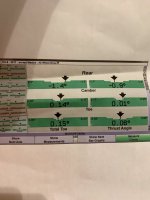Driving home tonight I thought my tires were singing a bit, so when I stopped I checked--sure enough, "lots" of feathering on the rear. And some excessive shoulder wear too it seems. Nature of the beast? Only have about 5k on the tires, so just barely rotation time. I did have it aligned a year ago (22kmiles?), so it shouldn't be out this early.
So, can tall tread feather more quickly than half worn tires, or is it basically the same? I don't think I drive it that hard, but apparently these tires think otherwise. [Prior tires that came off were same brand & type, RT43 in 195/70R14.]
So, can tall tread feather more quickly than half worn tires, or is it basically the same? I don't think I drive it that hard, but apparently these tires think otherwise. [Prior tires that came off were same brand & type, RT43 in 195/70R14.]


